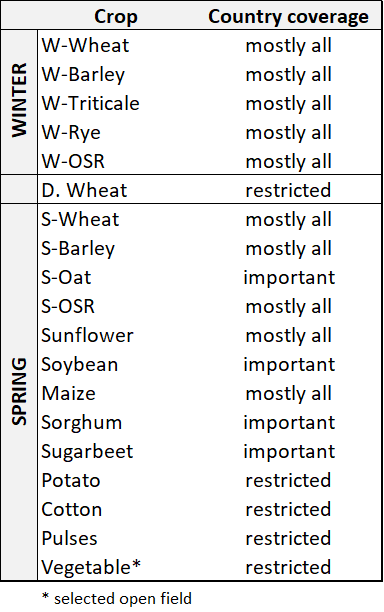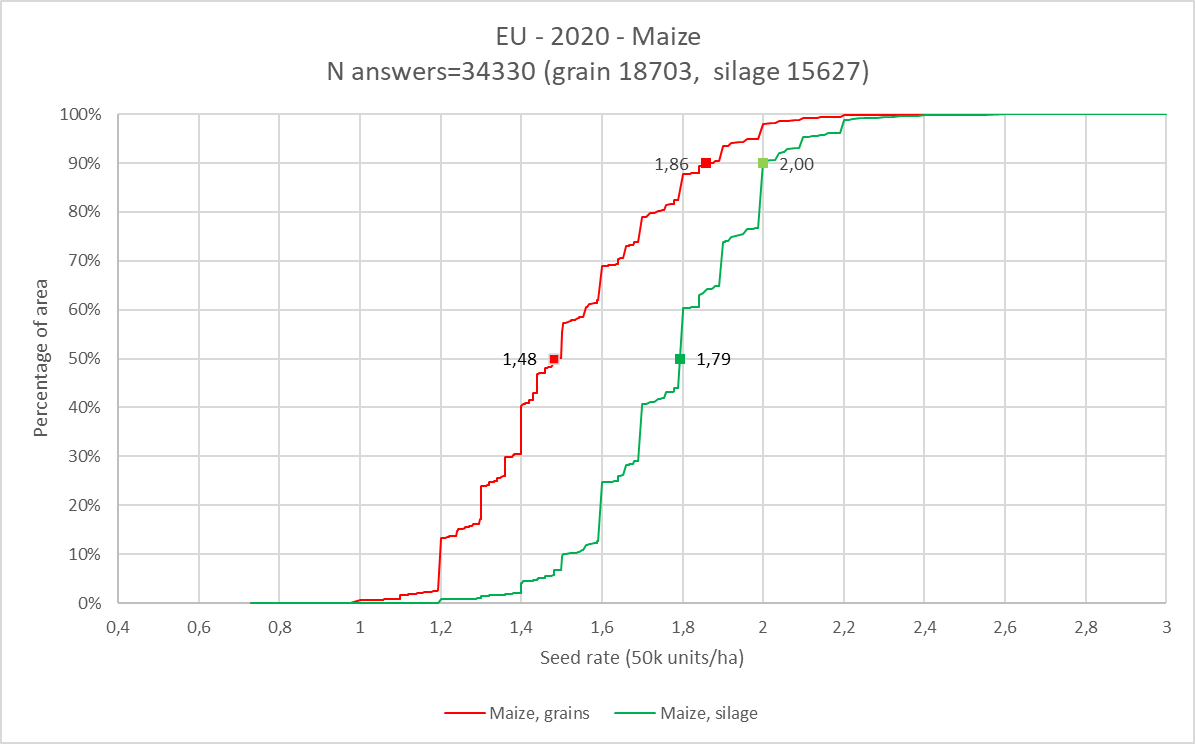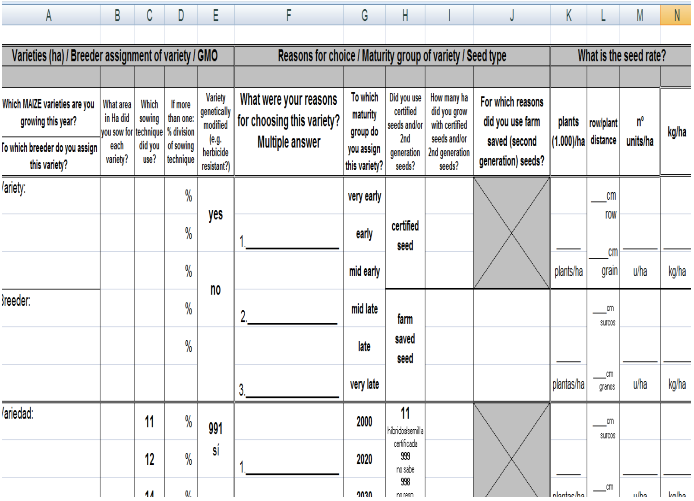Selectați limba, vă rog, din colțul din dreapta!
Selectați limba dorită, (română), din colțul din dreapta sus !
On farm sowing rate survey for major European field crops
A. Marfi, B. Neumann at Kynetec, Mühlenstraße 1, 59348 Lüdinghausen
1. Introduction
Over the years, seed breeding targeted higher seed quality to ensure that each seed will develop in a healthy plant. Sowing techniques have improved in parallel to ensure each seed is placed at the right distance to balance yield and competition for water and nutrients. Maize sowing density is directly link to water availability. In case of irrigation, higher density is possible. Precision agriculture is going even further by adjusting seed spacing to soil mapping. Of course, cereals are still subject to climate and regular rains, as such sowing rates for cereals reflect EPPO climatic zones.
Maize and sunflower are 100% hybrid seeds, OSR is 93 % hybrid. Because of difficult production, hybrid seeds are all supplied by industrial seed companies. Cereals seeds are mainly open pollinated. For that reason these seeds can be recycled at farm level. Farm saved seeds represent 50 % of winter wheat surfaces and 42% of barley surfaces in Europe. Sowing rate of farm saved seeds is higher because sorting and cleaning techniques are less refined and therefore physical purity, genetic purity, germination rate are lower.
V. Lucchesi et al (2016) conducted a survey on sowing rate of various crops in Europe. This survey aimed at consulting experts on minimum, maximum and most commonly used sowing rates in the different countries covered. The sowing rate is a critical input for the risk assessment of plant protection product used as seed treatments. In Europe, protection goals used in risk assessment are often set to cover 90% of cropping area. The selection of the maximum sowing rate should reflect the market conditions of such crop.
The present paper presents the outcome of a broader consultation based on direct farmer interviews in commercially relevant countries for major European field crops. This method allows a statistical calculation of the 90% percentile sowing rate for the main field crops: winter wheat, maize, winter oilseed rape and sunflower.
2. Methodology
Kynetec has been in the market survey business for the last 30 years, and is specialized in agriculture (crop production, animal health, machinery). The operating range of the company includes both custom surveys designed for one client and syndicated studies, involving farmer panels in crop protection, seed, seed treatment and fertilizers. These panels have been conducted in all relevant markets for the last 30 years. Relevant markets are defined regionally by cultivated area and for specific crops.

Figure 1: description of the coverage informed by the survey, per country and per crop.
Country coverage is defined below:
- Mostly all: the survey covers > 80% of the cropping area in Europe.
- Important: the survey covers the most commercially important countries for the crop i.e. 65-80% of the cropping area.
- Restricted: the survey covers fewer countries or <65% of the cropping area
Such surveys are conducted by via phone calls, online interviews or face to face interviews using a standardized questionnaire being similar across the different geographies. The procedure used enables to monitor trends over time and across countries and enables a direct comparison of the results. The questionnaire can be consulted in Appendix 1.
Sampling of farmers
The stratified sampling is set up including both the cultivated area per region, crop / farm size classes, and crop utilization. The proportion of sample strata should reflect the population. Data source for the crop areas are generally produced annually by national statistical offices. Data for farm or crop size classes are produced by official statistics, but not on an annual basis. Farm census are performed generally in Europe, on a seven-year basis. The latest census data is from 2017. In the meantime, the concentration rate or attrition rate are mapped every year for crop area and farm size. These maps are adjusted every year until a new census is available. Such adjustments are made from answers to our surveys when not matching the expected regional distribution. Annual number of interviewed farms per crop and country follow relative growing area in the respective country (see Table 2 for 2020 surfaces and interviews).

Table 2: Official 2020 cropping area and number of interviewed farms
Extrapolation of results
After farm interviews were completed, a weighting factor was calculated (weighting factor = total statistical area (per crop & segment)/ covered area) and attributed to each interview according to the following formula: weighting = weighting factor * interview data (product area, tank mix area etc.). The results were extrapolated to the total market in terms of area. In some countries, they also offer extrapolation based on the number of farms, where statistical data is available for farm size classes.
Reliability of the results
The margin of error of the seed panel was estimated to be within ~1-1.5% on European, and ~1-5% on country level. The reliability of the results was also confirmed by the consistency of the results over 30 years research, and the track record with seed company clients who confirmed the results.
3. Sowing rate results for major field crops
Maize
Climate is the major driver for type of maize grown. Grain maize is more present in South of Europe like Romania, France, Hungary. These countries being main producers of maize seeds and export these seeds in Europe and beyond. The higher average sowing rate for grain maize is observed in France as there is a larger irrigation system than in the rest of Europe. Silage maize is predominant in Germany and Poland. The average sowing rate for silage maize is higher than the grain maize one, as the crop is harvested at an earlier stage when water competition is not playing for grain maturity. Reduction of average sowing rate for silage maize in Poland is explained by adoption of better seeds with higher germination rate.
European Union, 2011-2020 – average seed rate for grain and silage maize in EU and major 5 countries for the respective use(seeds/ha)

European Union, 2020 – grain and silage corn sowing rate distribution
Data include following countries: ES, FR, NL, BE, DE, DK, AT, PL, CZ, SK, HR, HU, RO, BG, IT
Median sowing rate for grain maize is 1.48 unit (50 kseeds) /ha or 74 000 seeds/ha, while the rate for silage maize- increases to 1.79 unit (50 kseeds)/ha or 89 500 seeds/ha.
90th percentile sowing rate for grain maize is 1.86 unit (50 kseeds)/ha or 92 000 seeds/ha while for silage maize increases to 2 units (50 kseeds)/ha or 100 000 seeds/ha.
Winter OSR
Hybrid oilseed rape seeds have been adopted largely in Europe. There are still some open pollinated variety for 7% of European surfaces and mainly planted in Poland, UK and France. Average sowing rates are quite stable over the years for both hybrid and open pollinated winter oilseed rape. Average sowing rate for hybrid seeds is lower than for open pollinated seeds. However, median sowing rates are similar for hybrid WOSR 0.32 unit (1500 kseeds) /ha or 480 000 seeds/ha, and for open pollinated WOSR 0.33 unit (1500 kseeds)/ha or 495 000 seeds/ha. 90th percentile sowing rate for hybrid WOSR is 0.4 unit (1500 kseeds)/ha or 600 000 seeds/ha while the rate for open pollinated WOSR increases to 0.5 unit (1500 kseeds)/ha or 750 000 seeds/ha.
European Union, 2011-2020 – average seed rate for hybrid and open pollinated winter oilseed rape in EU and major countries relative to seed nature (1000 seeds/ha)

European Union, 2020 - hybrid and open pollinated winter oilseed rape sowing rate distribution
Data include all European winter oilseed rape growing countries: FR, DE, DK, PL, LV, CZ, SK, HU, RO, BG
Winter wheat
European Union, 2011-2020 – certified and farm saved seed winter wheat average sowing rate (kg/ha)

European Union, 2019 – certified and farm saved seed winter wheat sowing rate distribution
Data include following countries: DE, DK, SE, AT, PL, CZ, SK, HU, RO
Sunflower
Higher average sowing rate for sunflower is observed in France because of more regular water resources. The overall European average sowing rate increases because of larger proportion of oleic and high oleic variety which can be planted at slightly larger sowing rate. See trend on next graph.
European Union, 2011-2020 – hybrid sunflower average sowing rate in major growing countries (1000 seeds/ha)

European Union, 2020 – hybrid sunflower sowing rate distribution
Data include following countries: ES, FR, SK, HU, RO, BG
Median sowing rate for sunflower is 0.43 unit (150 kseeds) /ha or 64 500 seeds/ha.
90th percentile sowing rate for grain maize is 0.5 unit (150 kseeds)/ha or 75 000 seeds/ha.
4. Discussion for other crops
The selection of maximum sowing rate for evaluation of plant protection products used as seed treatment should represent the economic conditions of the crops. Based on the sunflower example, the maximum sowing rate for sunflower is 200 000 seeds /ha for Netherlands. But cropping area for that country is 600 ha while sunflower is cultivated on more than 4 million ha in EU. This high sowing rate in the Netherlands is used for cutting flower production not for oil like in the rest of EU. It is recommended to balance national crop expert approach with relative cropping area of the country and in such way to match targeted protection goal- of 90% of cropping area. Failure to do so will result in distorted view of the sowing rates for some crops which in turn lead to unrealistic risk assessments.
References
V. Lucchesi et al (2016), Results of the EPPO Survey on dose expression for seed treatment and authorized dose for plant protection products in general EPPO Survey on dose expression and authorized dose.
Appendix
1
